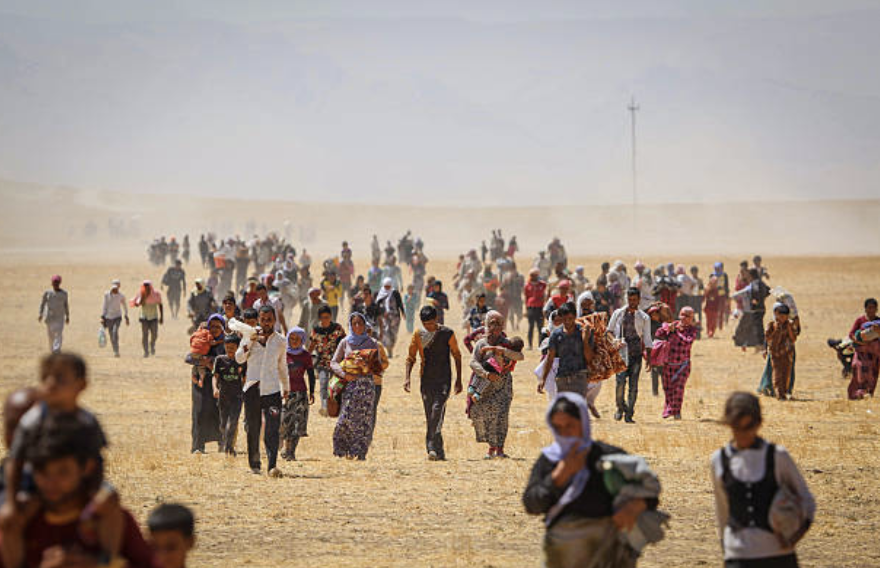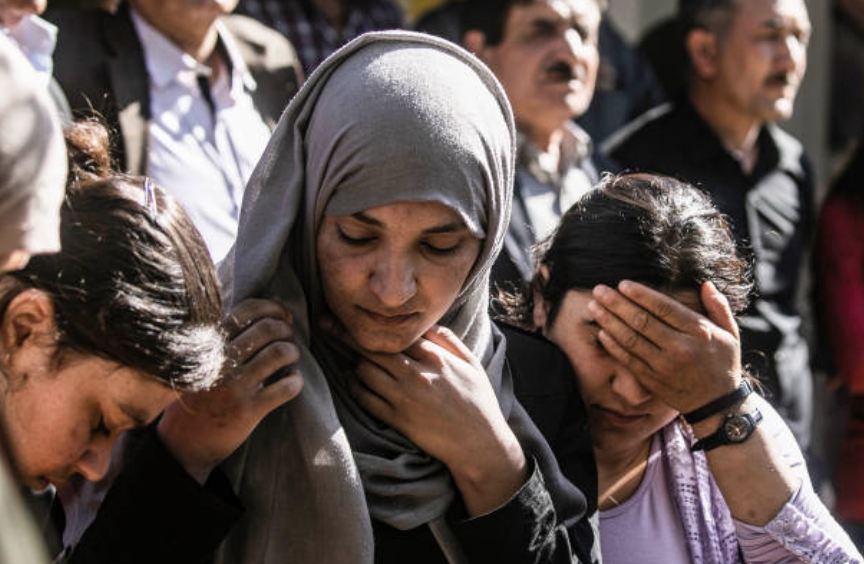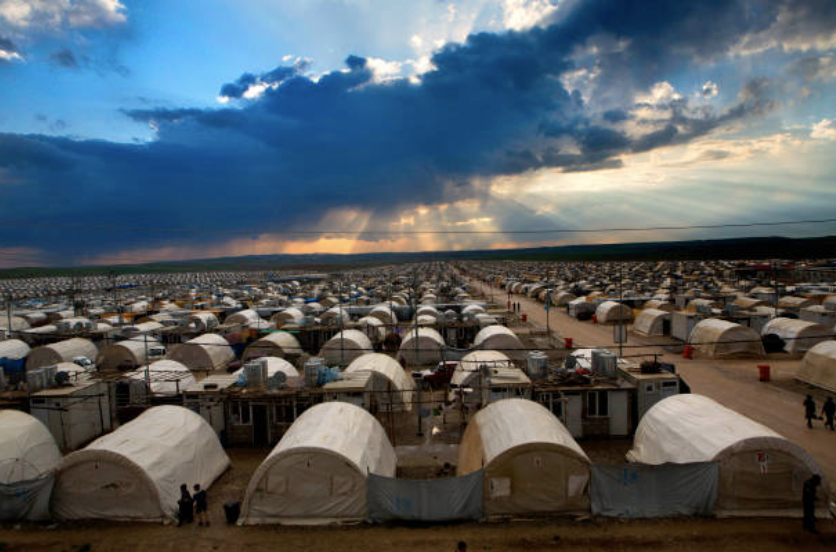Tired of displacement, Iraq’s Yazidi minority return home
The 2014 ascendancy and territorial control by the Islamic State of Iraq and the Levant (Daesh) has displaced more than 3.3 million Iraqis. Of these 3.3 million Internally displaced Persons (IDPs), 1.3 million remained displaced, according to data from UNHCR and IOM, with over half displaced for more than three years.[i] From damaged or destroyed livelihoods to security concerns and legal complications, displaced Iraqis have been unable to return to their areas of origin.
Since June 2020, displaced Yazidi families in Iraq have finally started to return to Sinjar district, located in western Nineveh province on the border with Syria, following six years of displacement. Exhausted by displacement, coupled with fear of the COVID-19 pandemic breaking out inside IDP camps and a relatively improved security environment in Sinjar, Yazidis are returning. Challenges facing IDPs upon return include poor basic services, damaged infrastructure, lack of adequate health and education facilities, social and security tensions and landmine contamination.
More than 1,200 displaced Yazidi families have returned home since June, according to Mahma Khalil, the exiled Mayor of Sinjar who currently resides in the Kurdistan region.[ii] According to a recent assessment conducted by the IOM in Iraq, some 10,165 Yazidis returned to Sinjar between 08 June and 16 July which marked an increase over previous years. In May and June of 2019, IOM Iraq recorded only 1,512 individuals returning to Sinjar and Baaj, the neighboring district. [iii]
Nayif Shamo, a 54-year-old Yazidi man who returned to his area of origin in Kahtaniya sub-district in mid-June 2020, told ARK that the primary factor behind his decision to return was that he was “tired of displacement”. “I think it is time for all of us to return,” he added. Fear of the COVID-19 pandemic breaking out in the camp and easier legal processes for IDP return were also significant factors behind Shamo’s decision. “We were a household of 10 individuals living inside one tent. If one of us had caught the virus, others would have also got infected for sure,” he said. Other motivating factors, according to Shamo, included improved security and stability in the area.
Meanwhile, armed groups in the area and the lack of job opportunities represent serious obstacles for many Yazidi IDPs who prefer to stay displaced amid poor living conditions.
ARK also interviewed Jalal Antari, 29, who remains displaced inside Bajit Kandala IDP camp located in western Dohuk governorate and works at one of the camp’s health centers. He attributed the reason for not returning home to lack of security due to the presence of multiple armed groups in the area, poor basic services such as electricity and water, and poor health facilities in the district. Antari used to live in Khana Sor, a village located in western Sinjar district and currently predominately controlled by the Sinjar Resistance Units, an armed group affiliated with the Kurdistan Workers Party (PKK). “There are armed group in my area who operate outside the state’s control,” said Antari, referring to Sinjar’s Resistance Units. He also added that he could not recognize his friends from his enemies anymore. “Despite the harsh living conditions inside the camp, I prefer staying here [in the camp] than going back to my area amid the current circumstances,” added Antari.
Movement restrictions related to the COVID-19 pandemic have further worsened the poor living conditions inside the Baadre IDP Camp in southern Dohuk governorate, where Shamo used to live. “Aid distribution by NGOs and CSOs has significantly decreased due to movement restrictions,” Shamo said.
The interviewee also added that he and his fellow returnees face significant challenges upon return. These included shortages of electricity and water supplies, damaged or destroyed private properties such as houses and shops, and contamination by mines and UXO.
Despite those challenges, Shamo expressed optimism towards his future. “Prior to displacement, farming was our livelihood. My land is still there, and I will resume preparing and cultivating it for farming once I am fully settled,” he said.
Many areas, especially in southern Sinjar district, remain contaminated by landmines and explosives remnants of war despite ongoing demining and clearance activities by the government as well as some NGOs. “Children of my relatives in Adnaniyah village cannot play freely in the area due to the presence of explosives,” Shammo said, adding that “the demining activities are slow, and it takes too much time to clear the area. Those efforts need to be scaled up.”
Shamo believes that providing more basic services such electricity and water supplies is crucial for him and his fellow returnees in the area. He also added that the area needs more health and education facilities as well as infrastructure developments.
Yazidis are the second largest religious minority in Iraq, after the Christians. They believe in Yazidism, which is an ancient faith with a rich oral tradition that integrates some Islamic beliefs with elements of Zoroastrianism, the ancient Persian religion, and Mithraism, a mysterious religion originating in the Eastern Mediterranean.[iv] The majority of the Yazidi population remaining in the Middle East live in Iraq, primarily in Nineveh and Dohuk provinces. Prior to Daesh’s ascendancy, the estimated number of Yazidis living in Iraq was 550,000. The 2014 conflict pushed some 100,000 Yazidis to seek asylum in Europe, the United States, Australia, and Canada. To date, it is estimated that some 360,000 Yazidis still live in displacement, primarily inside IDP camps in Iraq’s Kurdistan region. [v]
Many of the Yazidis fled their homes in August 2014 as Daesh swept into their areas and captured Sinjar district, in western Nineveh province, and its neighboring towns and villages. Daesh perceives all other ethnic and religious groups as Kuffar (unbelievers) and seeks to eliminate those who do not subscribe to its Sunni extremist ideology. According to a June 2016 report by the Office of the United Nations High Commissioner for Human Rights (OHCHR), more than 400,000 Yazidis, including men, women, and children, have been displaced, captured, or killed during the August 2014 Sinjar massacre, an event which marked the genocide of the Yazidis by Daesh. Many women were taken as sex slaves, others were asked to convert to Islam or face death. [vi]
While voluntary return is considered a durable solution for the displacement issue in Iraq, lack of livelihoods opportunities, reconciliation and social cohesion efforts, and insufficient infrastructure development in areas witnessing IDP returns risk endangering returnees and exposing them to a secondary wave of displacement.
In her end of mission statement upon conclusion of her official visit to Iraq in February 2020, the United Nations Special Rapporteur on the Human Rights of Internally Displaced Persons, Ms. Cecilia Jimenez-Damary, concluded that “the conditions in places of return and the durable solutions available to IDPs remain of paramount concern.” [vii]
[i] “Iraq Refugee Crisis,” UNHCR - https://www.unrefugees.org/emergencies/iraq/
[ii] “Displaced Yazidis head back to Sinjar as coronavirus lockdown bites,” Reuters, 6 July 2020 - https://reut.rs/2ZizNSM
[iii] “Six Years After Sinjar Massacre, Support and Services are Vital for Returning Yazidis,” UNDP, 02 August 2020 - https://bit.ly/2E1Fkpp
[iv] “Who are the Yazidis, the ancient, persecuted religious minority struggling to survive in Iraq?” National Geographic, 11 August 2014 - https://on.natgeo.com/2Xat5gq
[v] “Iraqi Yazidis, in numbers,” Al-Hurra, 15 July 2019 - https://arbne.ws/3azMnl4
[vi] “They came to destroy: ISIS Crimes Against the Yazidis,” OHCHR, 15 June 2016 - https://bit.ly/33eaZwm
[vii] “End of Mission Statement by the United Nations Special Rapporteur on the human rights of internally displaced persons, Ms. Cecilia Jimenez-Damary, upon conclusion of her official visit to Iraq – 15 to 23 February 2020,” OHCHR - https://bit.ly/2GpPJfD



